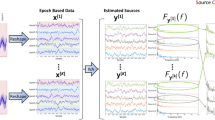Abstract
The aim of the study was to investigate the effect of signal length on the performance of a signal source separation method, independent component analysis (ICA), when extracting the visual evoked potential (EP) lambda wave from saccade-related electro-encephalogram (EEG) waveforms. A method was devised that enabled the effective length of the recorded EEG traces to be increased prior to processing by ICA. This involved abutting EEG traces from an appropriate number of successive trials (a trial was a set of waveforms recorded from 64 electrode locations in a study investigating saccade performance). ICA was applied to the saccade-related EEG and electro-oculogram (EOG) waveforms recorded from the electrode locations. One spatial and five temporal features of the lambda wave were monitored to assess the performance of ICA applied to both abutted and non-abutted waveforms. ICA applied to abutted trials managed to extract all six features across all seven subjects included in the study. This was not the case when ICA was applied to the non-abutted trials. It was quantitatively demonstrated that the process of abutting EEG waveforms was useful for ICA preprocessing when extracting lambda waves.
Similar content being viewed by others
References
Amari, S., Cichocki, A., andYang, H. (1996): ‘A new learning algorithm for blind signal separation’,Adv. Neural Inf. Process. Syst.,8, pp. 757–763
Barlow, J. S., andCiganek, L. (1969): ‘Lambda responses in relation to visual evoked responses in man’,Electroenceph. Clin. Neurophysiol.,26, pp. 183–192
Bell, A. J., andSejnowski, T. J. (1995): ‘An information-maximization approach to blind separation and blind deconvolution’,Neural Comput.,7, pp. 1129–1159
Cardoso, J.-F. (1999): ‘High-order contrasts for independent component analysis’,Neural Comput.,11, pp. 157–192
Cichocki, A., Karhunen, J., Kasprzak, W. andVigário, R. (1999): ‘Neural networks for blind separation with unknown number of sources’,Neurocomputing,24, pp. 55–94
Ditchburn, R. W. (1973): ‘Eye-movements and visual perception’ (Clarendon Press, Oxford, 1973)
Electrical Geodesics, Inc. Internet site address: http://www.egi.com/
Green, J. (1957): ‘Some observations on lambda waves and peripheral stimulation’,Electroenceph. Clin. Neurophysiol.,22, pp. 204–209
Hyvärinen, A. (1999): ‘Survey on independent component analysis’,Neural Comput. Surv.,2, pp. 94–128
Leventhal, A. G. (Ed.) (1991): ‘The neural basis of visual function, Vol. 4’ (Macmillan, Vision and Visual Dysfunction Series, Basingstoke, 1991)
Skrandies, W., andLaschke, K. (1997): ‘Topography of visual brain activity during eye movements: lambda waves, saccadic suppression, and discrimination performance’,Int. J. Psychophysiol.,27, pp. 15–27
Statistical Analysis System (SAS) (1982): ‘SAS user's guide: statistics’ (SAS Institute Inc., Box 8000, Cary, North Carolina 27511)
Thickbroom, G. W., Knezevic, W., Carroll, W. M., andMastaglia, F. L. (1991): ‘Saccade onset and offset lambda waves — relation to pattern movement visually evoked potentials’,Brain Res.,551, pp. 150–156
Vigon, L., Saatchi, M. R., Mayhew, J. E. W., andFernandes, R. (2000a): ‘A quantitative evaluation of techniques for ocular artefact filtering of EEG waveforms’,IEE Proc. Sci. Meas. Technol.,147, pp. 219–228
Vigon, L., Saatchi, R., Mayhew, J., Taroyan, N. andFrisby, J. (2000b): ‘Independent component analysis of saccade-related electroencephalogram waveforms’,Electron. Lett.,36, pp. 1006–1007
Author information
Authors and Affiliations
Corresponding author
Rights and permissions
About this article
Cite this article
Vigon, L., Saatchi, R., Mayhew, J.E.W. et al. Effect of signal length on the performance of independent component analysis when extracting the lambda wave. Med Bio Eng Comput 40, 260–268 (2002). https://doi.org/10.1007/BF02348134
Received:
Accepted:
Issue Date:
DOI: https://doi.org/10.1007/BF02348134




